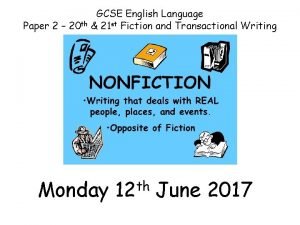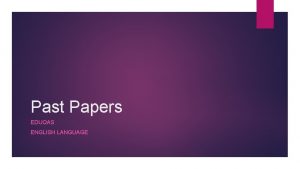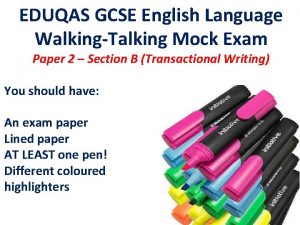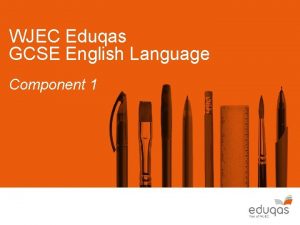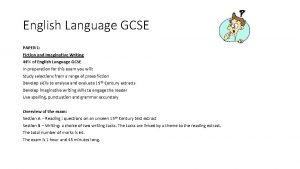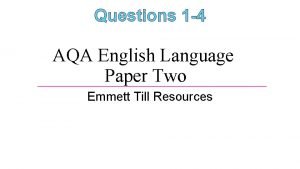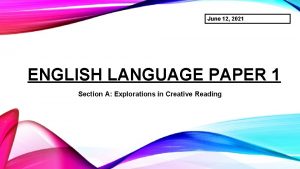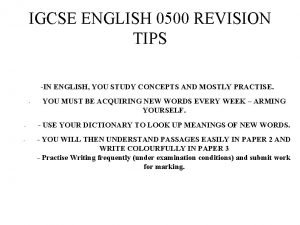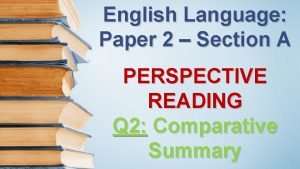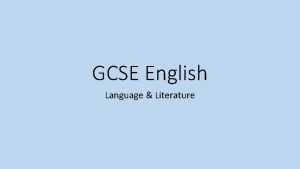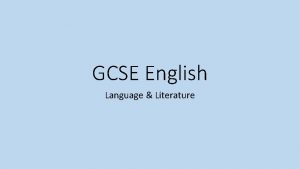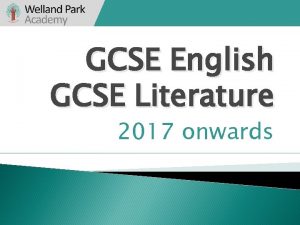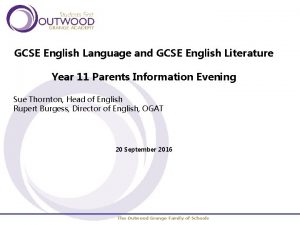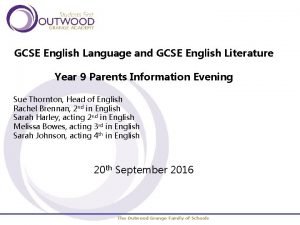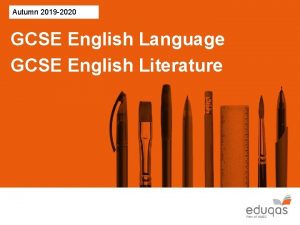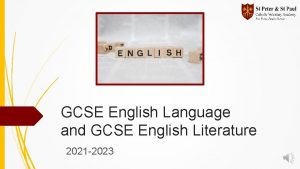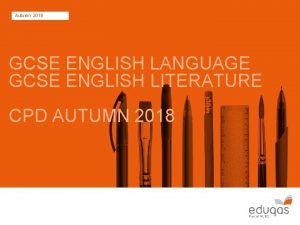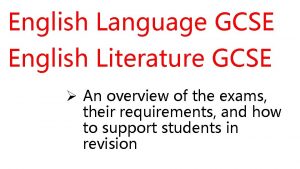GCSE English Language Paper 2 20 th 21












- Slides: 12

GCSE English Language Paper 2 – 20 th & 21 st Fiction and Transactional Writing Monday th 12 June 2017

In this exam, you have to complete two sections: Section A: Reading. You will need to read two 20 th & 21 st century non-fiction texts and answer seven questions in which you will have to find quotations, make inferences, analyse the language and structure and evaluate the text. Approximately 1 hour 15 Minutes Section B: Writing. You will need to choose one of two questions and construct a transactional piece of writing. Approximately 45 Minutes.

AO 1 Identify and interpret explicit and implicit information and ideas Select and synthesise evidence from different texts AO 2 Explain, comment on and analyse how writers use language and structure to achieve effects and influence readers, using relevant subject terminology to support their views. AO 3 Compare writers’ ideas and perspectives, as well as how these are conveyed, across two or more texts Evaluate texts critically and support this with appropriate textual references AO 4 Identifying relevant quotations Interpretations Synthesising Paper 2 Q 1 (2 marks) Paper 2 Q 4 (1 mark) Paper 2 Q 7 a (6 marks) Language Structure Effect on reader Subject terminology Paper 2 Q 2 (2 marks) Paper 2 Q 3 (15 marks) Paper 2 Q 5 (1 mark) Comparison Paper 2 Q 7 b (14 marks) Evaluation Critical writing Textual references Paper 2 Q 6 (15 marks)

Section A: Reading Question One (AO 1) 2 Marks – 3 – 4 Minutes Underline the line references. Box out the lines on the text. Re-read the question, identifying the focus. Highlight everything that is relevant to the question. Choose one phrase or sentence and copy this directly using quotation marks. Question Two (AO 1, AO 2) 2 Marks – 3 -4 minutes Underline the line references Box out the lines on the text Re-read the question, identifying the focus. Highlight everything that is relevant to the question. Choose one example of HOW the writer uses language and copy this before giving a brief explanation of the effect created.

Question Three – Analysing language and structure(AO 2 – 15 Marks) Before you begin answering this question, you must know the following techniques. If you know the following techniques, you will be able to analyse the text you have been given. Language Noun – a person, place or thing Abstract nouns - feelings Verb – an action or a state Adjective – a describing word (describes the noun) Adverb – a describing word (describes the verb) Simile Metaphor Personification Onomatopoeia Structure Short sentences Multi clause sentence – a sentence containing lots and lots of clauses to build up details Declarative sentence – a statement Exclamatory sentence – a sentence ending in an exclamation (use of exclamation mark) Interrogative sentence – a question Imperative – a command Repetition Openings/Endings Shifts in time/place

Question Four (AO 1) 1 Mark – 1 – 2 Minutes Underline the line references. Box out the lines on the text. Re-read the question, identifying the focus. Highlight everything that is relevant to the question. Choose one phrase or sentence and copy this directly using quotation marks. Question Five (AO 2) 1 Mark – 1 -2 minutes You will be given an example from the text. From this example select a short phrase to explain HOW the writer uses language.

Question Six - 15 Marks (AO 4) In this extract, there is an attempt to create …. Evaluate how successfully this is achieved. Support your views with detailed reference to the text. The key here is ‘how well’ the writer has created … Identify key: Settings – where and when? Ideas – what does the writer think/believe? Themes – what is the text’s tone or purpose? Events – what happens or is described? DO quote or paraphrase to back up your points DON’T analyse language or structure in detail – for example, you could observe ‘The phrase “wild boggy moor” foreshadows the danger to come’ – but you don’t need to discuss the connotations of the words of the phrase itself.

Question 7 a – 6 Marks (AO 1) The two texts show__________________________. What similarities do they share? Use evidence from both texts to support your answer. Similarity 1 • Evidence from Text 1 • Evidence from text 2 Similarity 2 • Evidence from Text 1 • Evidence from text 2 Similarity 3 • Evidence from Text 1 • Evidence from Text 2

Question 7 b – 14 Marks (AO 3) Compare how the writers of Text 1 and Text 2 present their ideas and perspectives about ____________________________. Support your answer with detailed reference to the text. 1. Identify how the ideas and perspectives of the writers are similar & find evidence from both texts to back up your ideas 2. Identify how the ideas and perspectives of the writers are different & find evidence. You CAN use part of your answer from 7 a if relevant.

P 2 Section B: Transactional Writing EITHER *8 Write a ___________to____________________ In your _______ you could write about: • ______________ Both questions will ask you to write in a specific form for a specific audience • ___________________________ 40 marks = 40 minutes As well as any other ideas you might have. You only need to answer ONE of these questions (Total for Question 8 = 40 marks) *OR 9 Write a ___________for____________________ In your _______ you could write about: Both questions will give you 3 bullet • ______________ points of things you should include. USE THIS AS YOUR PLAN – EACH • ______________ POINT = A PARAGRAPH. You can add • ______________ another paragraph of your own ideas. As well as any other ideas you might have. (Total for Question 9 = 40 marks) *Your response will be marked for the accurate and appropriate use of vocabulary, spelling, punctuation and grammar. You need to read through your work VERY carefully to check SPa. G. Leave enough time for this at the end.

P 2 Section B: Transactional Writing Forms of Writing: You will be asked to write in a specific form for a specific audience. The form could be any of the following: • Formal letter You MUST lay it out properly and use the appropriate greeting and signing off. • Newspaper article Use a headline, short paragraphs starting with a summary paragraph, include interviews with witnesses, etc. but DO NOT write in columns or draw pictures! • Magazine article As above • Speech Address your audience directly. Use persuasive techniques and pauses, etc. • Diary entry Start it with a date, time and place. NOT ‘Dear Diary’! • Information Leaflet Write information in small chunks. Do not attempt to lay it out like a leaflet. You must use the rules and conventions of that form properly. Audience When writing for a specific audience, you need to consider the following: • Register – how formal or informal does the writing need to be? • Vocabulary – what types of word are suitable for the audience? Do I need to use any specialist vocab? Use SPa. G Correctly • Take your time to write properly • Check your work VERY CAREFULLY

YOU CAN DO THIS!! Good Luck Year 11 üMs Reilly üMr Pillar üMiss Vaudry üMiss Keene üMrs Bissett
 Edexcel gcse english language past papers 9 1
Edexcel gcse english language past papers 9 1 English language paper 2 transactional writing
English language paper 2 transactional writing Edexcel paper 1 literature
Edexcel paper 1 literature Gcse english language paper 1 question 2
Gcse english language paper 1 question 2 English general paper paper 2 comprehension
English general paper paper 2 comprehension Eduqas english language past papers
Eduqas english language past papers Eduqas gcse english language past papers
Eduqas gcse english language past papers Eduqas gcse english language
Eduqas gcse english language English fiction and imaginative writing
English fiction and imaginative writing Aqa english language paper 1
Aqa english language paper 1 English paper 1 june 2021
English paper 1 june 2021 Igcse english language tips
Igcse english language tips Aqa english language paper 2 rail disasters mark scheme
Aqa english language paper 2 rail disasters mark scheme

